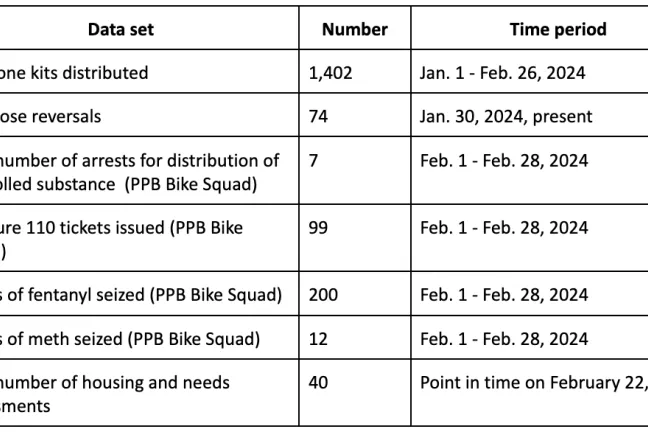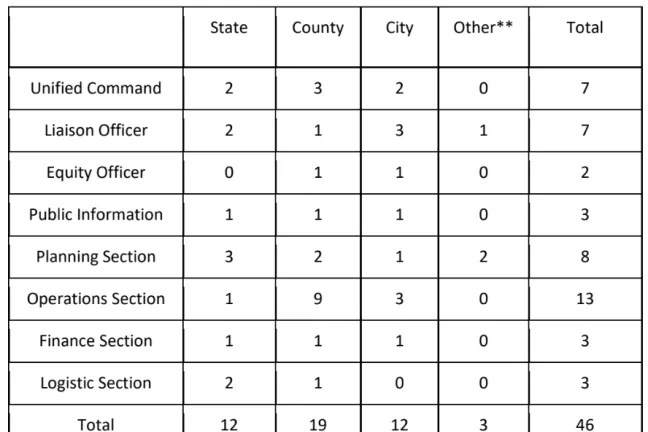Executive summary
This report shares data and activities directed by Unified Command for the Incident Management Team (IMT). The information in this report comes from a joint effort among the City, State and County. Please note that not all requested data is included yet, but we expect to add it as soon as it becomes available.
Objectives
- Leverage the city, state and county’s resources to improve livability in Portland’s city center.
- Enhance coordination and accessibility of housing, treatment, and recovery services in Portland.
- Combine health, law enforcement, and other data into a countywide dashboard for better response and monitoring.
- Identify housing, health and law enforcement gaps and obstacles, then make specific policy recommendations to leaders and lawmakers for better coordination.
- Develop a transition plan to expand and improve response efforts, with focus on both short-term and long-term needs.
Situation overview
- Between January 1, 2024 and February 26, 2024, 48 of 130 suspected or confirmed overdose deaths in Multnomah County were considered to be fentanyl-related.
- 12 fentanyl-related overdose deaths in the operational area (Jan. 30 - Feb. 26, 2024)
- There is an estimated 1-2 week lag in data availability for these numbers, so the February data point is very preliminary.
- Fentanyl-related 911 medical dispatches (countywide):
- 58 (January 2024)
- 57 (February 2024)
- Partial data for February 2024 show an estimated 134 opioid-related visits to emergency departments or urgent care in Multnomah County.
Key activities/highlights this week
This includes work happening at Unified Command’s direction and actions taken by partner agencies participating in the emergency declarations.
- Expanded a task force made up of law enforcement, fire and rescue resources, outreach and substance use disorder services, houseless navigation teams, and street clean up staff.
- This group meets every morning to coordinate and deploy resources on that day, and collaborate on efforts their teams can make to support one another.
- They also report on the previous day’s efforts, any barriers to meeting objectives, and provide feedback on longer-term needs to enhance these efforts.
- Launched and deployed an Overdose Response Team that has already responded to 27 non-fatal overdoses.
- Launched an in-field drug treatment team.
- Portland Street Response is now adding regular outreach to people impacted by fentanyl addiction in the impacted area.
- Launched a Narcan distribution team.
- Portland Police Bureau, Oregon State Police, and Multnomah County Sheriff’s Office are coordinating daily to raise law enforcement visibility and to organize multi-agency fentanyl dealing missions.
Reportable data
The Data team is working on gathering specific information for future reports, but not all of it is available yet due to legal and technical barriers. It might take 7 to 14 days before all the statistics are available.
Here are the categories of data being collected:
Tri-government coordination: Details about coordination meetings, including Incident Management Team and Rapid Needs Assessment Task Force meetings with representatives from various city, county, and state agencies.
Operations: Information like the average number of law enforcement officers in areas and the total number of arrests for drug dealing.
Outcomes:
These statistics are preliminary and will become more accurate over time. More data to come on seizures of narcotics and fentanyl, substance use treatment referrals, naloxone kit distributions, outreach accomplishments, naloxone and buprenorphine administrations, lights installed, and blocks cleaned.
We're actively working on getting these data and will share them publicly as soon as they’re available.
Staffing
As of Feb 26, there were at least 46 responders assigned to the incident, including city, county, and state personnel.
Who's involved
- State of Oregon
- Multnomah County
- City of Portland


